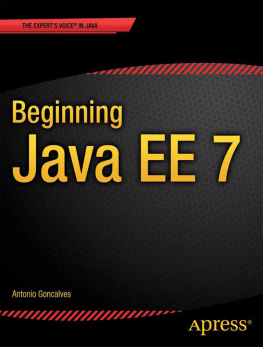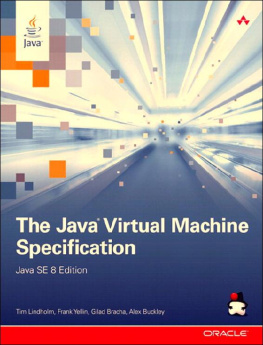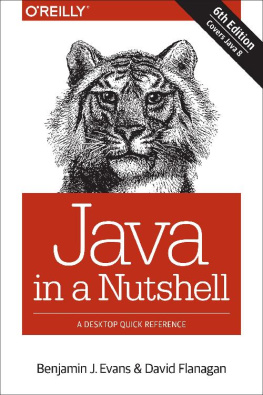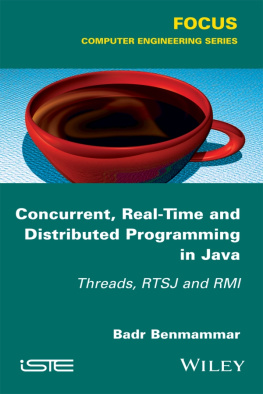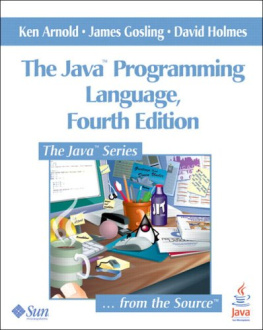Gosling JamesJoy BillSteele Guy L.Bracha - The Java Language Specification, Java SE
Here you can read online Gosling JamesJoy BillSteele Guy L.Bracha - The Java Language Specification, Java SE full text of the book (entire story) in english for free. Download pdf and epub, get meaning, cover and reviews about this ebook. year: 2014, publisher: Pearson Education Limited (US titles), genre: Home and family. Description of the work, (preface) as well as reviews are available. Best literature library LitArk.com created for fans of good reading and offers a wide selection of genres:
Romance novel
Science fiction
Adventure
Detective
Science
History
Home and family
Prose
Art
Politics
Computer
Non-fiction
Religion
Business
Children
Humor
Choose a favorite category and find really read worthwhile books. Enjoy immersion in the world of imagination, feel the emotions of the characters or learn something new for yourself, make an fascinating discovery.

- Book:The Java Language Specification, Java SE
- Author:
- Publisher:Pearson Education Limited (US titles)
- Genre:
- Year:2014
- Rating:3 / 5
- Favourites:Add to favourites
- Your mark:
- 60
- 1
- 2
- 3
- 4
- 5
The Java Language Specification, Java SE: summary, description and annotation
We offer to read an annotation, description, summary or preface (depends on what the author of the book "The Java Language Specification, Java SE" wrote himself). If you haven't found the necessary information about the book — write in the comments, we will try to find it.
The Java Language Specification, Java SE — read online for free the complete book (whole text) full work
Below is the text of the book, divided by pages. System saving the place of the last page read, allows you to conveniently read the book "The Java Language Specification, Java SE" online for free, without having to search again every time where you left off. Put a bookmark, and you can go to the page where you finished reading at any time.
Font size:
Interval:
Bookmark:
ePUB is an open, industry-standard format for eBooks. However, support of ePUB and its many features varies across reading devices and applications. Use your device or app settings to customize the presentation to your liking. Settings that you can customize often include font, font size, single or double column, landscape or portrait mode, and figures that you can click or tap to enlarge. For additional information about the settings and features on your reading device or app, visit the device manufacturers Web site.
Many titles include programming code or configuration examples. To optimize the presentation of these elements, view the eBook in single-column, landscape mode and adjust the font size to the smallest setting. In addition to presenting code and configurations in the reflowable text format, we have included images of the code that mimic the presentation found in the print book; therefore, where the reflowable format may compromise the presentation of the code listing, you will see a Click here to view code image link. Click the link to view the print-fidelity code image. To return to the previous page viewed, click the Back button on your device or app.
Java SE 8 Edition
James Gosling
Bill Joy
Guy Steele
Gilad Bracha
Alex Buckley

Upper Saddle River, NJ Boston Indianapolis San Francisco
New York Toronto Montreal London Munich Paris Madrid
Capetown Sydney Tokyo Singapore Mexico City
Copyright 1997, 2014, Oracle and/or its affiliates. All rights reserved.
500 Oracle Parkway, Redwood City, California 94065, U.S.A.
Many of the designations used by manufacturers and sellers to distinguish their products are claimed as trademarks. Where those designations appear in this book, and the publisher was aware of a trademark claim, the designations have been printed with initial capital letters or in all capitals.
Oracle and Java are registered trademarks of Oracle and/or its affiliates. Other names may be trademarks of their respective owners.
The authors and publisher have taken care in the preparation of this book, but make no expressed or implied warranty of any kind and assume no responsibility for errors or omissions. No liability is assumed for incidental or consequential damages in connection with or arising out of the use of the information or programs contained herein.
This document is provided for information purposes only and the contents hereof are subject to change without notice. This document is not warranted to be error-free, nor subject to any other warranties or conditions, whether expressed orally or implied in law, including implied warranties and conditions of merchantability or fitness for a particular purpose. We specifically disclaim any liability with respect to this document and no contractual obligations are formed either directly or indirectly by this document, except as specified in the Limited License Grant herein at , and may otherwise not be reproduced or transmitted in any form or by any means, electronic or mechanical, for any purpose, without our prior written permission.
The publisher offers excellent discounts on this book when ordered in quantity for bulk purchases or special sales, which may include electronic versions and/or custom covers and content particular to your business, training goals, marketing focus, and branding interests. For more information, please contact U.S. Corporate and Government Sales, (800) 382-3419, .
Visit us on the Web: informit.com/aw
Library of Congress Control Number: 2014936248
ISBN-13: 978-0-13-390069-9
ISBN-10: 0-13-390069-X
Printed in the United States of America. This publication is protected by copyright, and permission must be obtained from the publisher prior to any prohibited reproduction, storage in a retrieval system, or transmission in any form or by any means, electronic, mechanical, photocopying, recording, or likewise. To obtain permission to use material from this work, please submit a written request to Pearson Education, Inc., Permissions Department, One Lake Street, Upper Saddle River, New Jersey 07458, or you may fax your request to (201) 236-3290.
The Specification provided herein is provided to you only under the Limited License Grant included herein as .
Text printed in the United States on recycled paper at Edwards Brothers Malloy in Ann Arbor, Michigan. First printing, May 2014.
To Maurizio, with deepest thanks.
In 1996, James Gosling, Bill Joy, and Guy Steele wrote for the First Edition of The Java Language Specification:
We believe that the Java programming language is a mature language, ready for widespread use. Nevertheless, we expect some evolution of the language in the years to come. We intend to manage this evolution in a way that is completely compatible with existing applications.
Java SE 8 represents the single largest evolution of the Java language in its history. A relatively small number of features - lambda expressions, method references, and functional interfaces - combine to offer a programming model that fuses the object-oriented and functional styles. Under the leadership of Brian Goetz, this fusion has been accomplished in a way that encourages best practices - immutability, statelessness, compositionality - while preserving the feel of Java - readability, simplicity, universality.
Crucially, the libraries of the Java SE platform have co-evolved with the Java language. This means that using lambda expressions and method references to represent behavior - for example, an operation to be applied to each element in a list - is productive and performant out of the box. In a similar fashion, the Java Virtual Machine has co-evolved with the Java language to ensure that default methods support library evolution as consistently as possible across compile time and run time, given the constraints of separate compilation.
Initiatives to add first-class functions to the Java language have been around since the 1990s. The BGGA and CICE proposals circa 2007 brought new energy to the topic, while the creation of Project Lambda in OpenJDK circa 2009 attracted unprecedented levels of interest. The addition of method handles to the JVM in Java SE 7 opened the door to new implementation techniques while retaining write once, run anywhere. In time, language changes were overseen by JSR 335, Lambda Expressions for the Java Programming Language, whose Expert Group consisted of Joshua Bloch, Kevin Bourrillion, Andrey Breslav, Rmi Forax, Dan Heidinga, Doug Lea, Bob Lee, David Lloyd, Sam Pullara, Srikanth Sankaran, and Vladimir Zakharov.
Programming language design typically involves grappling with degrees of complexity utterly hidden from the languages users. (For this reason, it is often compared to an iceberg: 90% of it is invisible.) In JSR 335, the greatest complexity lurked in the interaction of implicitly typed lambda expressions with overload resolution. In this and many other areas, Dan Smith at Oracle did an outstanding job of thoroughly specifying the desired behavior. His words are to be found throughout this specification, including an entirely new chapter on type inference.
Another initiative in Java SE 8 has been to enhance the utility of annotations, one of the most popular features of the Java language. First, the Java grammar has been extended to allow annotations on types in many language constructs, forming the basis for novel static analysis tools such as the Checker Framework. This feature was specified by JSR 308,
Font size:
Interval:
Bookmark:
Similar books «The Java Language Specification, Java SE»
Look at similar books to The Java Language Specification, Java SE. We have selected literature similar in name and meaning in the hope of providing readers with more options to find new, interesting, not yet read works.
Discussion, reviews of the book The Java Language Specification, Java SE and just readers' own opinions. Leave your comments, write what you think about the work, its meaning or the main characters. Specify what exactly you liked and what you didn't like, and why you think so.

